Best Gardening Books For Portland Oregon?
From the backyard to the front, from the planting strip to the rooftop, no unpaved part of Portland has been safe from gardeners. We've been at it a long time—both for food and good looks. The luggage hauled in the wagons on the Oregon Trail included everything from our prized strawberries to cuttings of our namesake rose. Over the decades, we built a Japanese and a Chinese garden that know no rivals outside their countries of origin. Meanwhile, the Willamette Valley chapter of Tilth designed an organic certification program in 1982 that eventually became the model for the nation.
Today, a walk through virtually any neighborhood will attest to how seriously Portland home gardeners take their yards. The sopping winters and bone-dry summers had the savviest digging up their lawns years before water-conscious xeriscaping became a civic mandate in many American cities. Crafty Stumptowners were recycling all kinds of cast-offs into art well in advance of Martha Stewart's flashbulb.
In the following pages, we present a modest guide both for those who aspire to be the ultimate Portland gardener and for those who already are, but just want to refine their chops. Download this handy list of plants, nurseries, and other resources. But of our 50 tips, #1 requires nothing more than a shovel to …
Tip 1
Ditch the lawn. The first step to becoming a true Portland gardener is to go grass-free—at least free of the thirsty kind that's been bioengineered for the conventional American "lawn." Start by planting a rich tapestry of perennial flowers that will provide hummingbirds, bees, and other visitors with a feast from spring through early summer. Just figure out how tall you'd like your meadow to be, and get ready for a sweet, blowsy look.
Join the Horticultural Avant-Garde
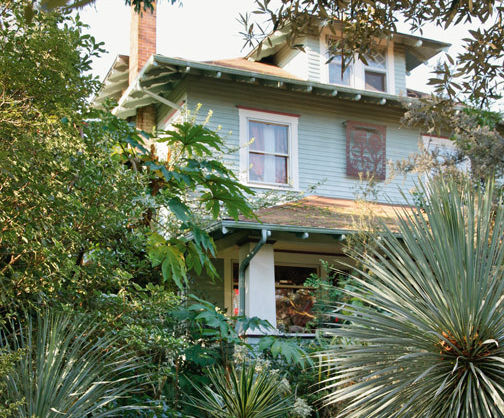
BECOME A HORTLANDIAN . There are quite enough junipers and barberries in the world, thank you. To dig deeper into the heart of Portland gardendom, visit Hortlandia: the Hardy Plant Society of Oregon's spring sale, April 7–8 at the Portland Expo Center. Dig even deeper by asking your favorite nurseries how they find their most exciting new plants.
GET SPIKY . Cacti and succulents are au courant among Stumptown gardeners. Get started with tough, addictively collectible little sedums and hens and chicks (Sempervivum). Push your acumen further with cold-hardy yucca and paddle cactus (Opuntia). Then go all the way with tender yet striking container plants, including Echeveria, aloe, and Aeonium—plants worth shuttling in and out again every year.
CREATE YOUR OWN HAWAII . We may think of bananas, palms, loquat, and passion vine as far too tender for Portland, but there are sturdy varieties that thrive in the Pacific Northwest. Banana (Musa basjoo), tough palms (Trachycarpus fortunei), passion vine (Passiflora caerulea), and loquat (Eriobotrya japonica) lend a thrillingly exotic look to your garden while requiring less care and attention than turf grass. And if you have a daylit basement, you can go truly tropical with red-leafed banana (Ensete maurelii) and exotic angel's trumpet (Brugmansia). Just drag them inside in the fall and then back out in the spring to watch them explode into growth.
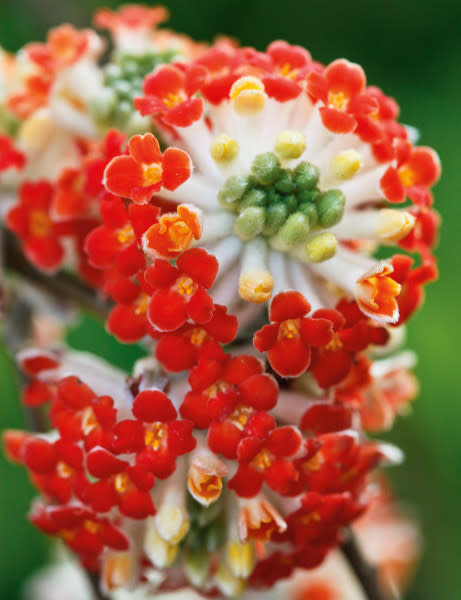
GROW OUT OF THE GRAY . Local gardeners know a secret about Portland winters: the dark and dreary is nothing more than background for eye-enchanting color. For bright golds, reds, and oranges, plant witch hazel; for pinks, red, and glistening white, go with winter camellias; for buttercup yellow, try winter hazel; hellebores make pinks, purples, pale yellows, peaches, and whites; and cyclamen blooms pale to hot pink. For knockout fragrance, plant winter-blooming honeysuckle and viburnum, winter sweet, sweet box, and daphne. For a more subtle beauty, try winter-blooming clematis, early spiketail, and silktassel.
RISE UP FROM THE GROUND . Inspired by Europe, Portlanders are exploring the beauty and ecological benefits of green roofs and living walls, whether atop government buildings like the Metro headquarters or stylish hot spots like Hotel Modera, where cocktails are served next to an eye-level patch of cliff-dwelling plants. Start with easy-to-install Woolly Pockets, or go to pros like Living Elements Landscape, who specialize in greening small spaces.
COLLECT IT. True garden devotees don't just plant plants; they collect them. Rare terrestrial orchids, clematis, agaves, or heirloom tomatoes: there's a Portland plant nerd searching for any plant variety you can think of. The Hardy Plant Society of Oregon is geek central for hobnobbing, seed-sharing, and lectures by renowned gardeners.
Expert Tips
Garden Style
Sean Hogan | Designer, consultant, and owner, Cistus Design Nursery

I was born and raised in Portland, but moved to the Bay Area and, there, served as a curator of the Berkeley Botanical Garden. When I moved back home to Portland, I found a wonderful and large established horticultural industry that catered to the East Coast rather than to us. Portland was still developing a garden style of its own. I started Cistus because it was hard to find Willamette Valley native plants without going to California! I wanted to plant local, low-elevation plants that were suited to our region, but I couldn't find them.
Pushing the horticultural boundaries can be rediscovering what we have in our own backyard. You can grow cool plants for all kinds of effects—tropical, rain forest, alpine, desert, whatever flora you want—but that are better adapted. What we have to discover and play with in our region is still so fun.
STARTER KIT
Soil: Most urban soils need better drainage. Chop in some pumice for dry-land plants, or compost for woodland plants.
Plants:Go ahead, try palms, banana, pomegranate, agaves, evergreen oaks, and other fun plants that remind us that we live on the West Coast! But don't neglect plants from our region, which firmly ground us with a sense of place.
Tune in to the Climate
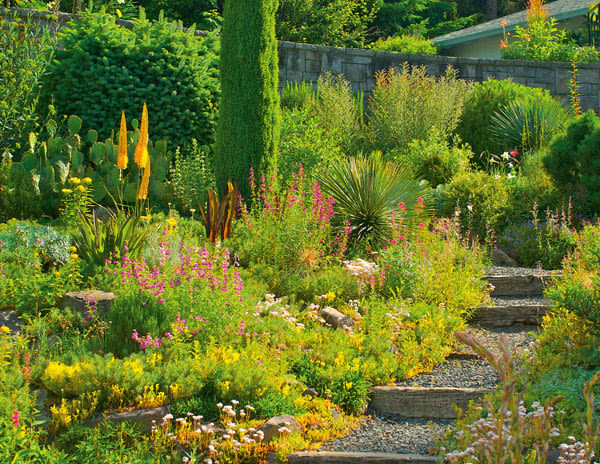
MAP IT. Every yard has a variety of different growing environments, or microclimates. A great way to plan your garden is by sketching a map. Take a monthly walk through your yard for a year, noting south- and west-facing walls that reflect heat, sunny spots that will dry out, and shady areas destined to stay damp into late spring. Note where you have poor soil or tangles of tree roots and, if you're lucky, patches of dark, rich loam. With a detailed map to work with, a good horticultural professional can offer advice on what to plant where.
GROW WITH THE WATER . In the quest for striking plant combinations, even the best designers forget this rule. Picture a desert oasis in your yard—with a lushly planted core beside the spring (your hose bib or downspouts), surrounded by progressively more drought-tolerant plantings toward the edges.
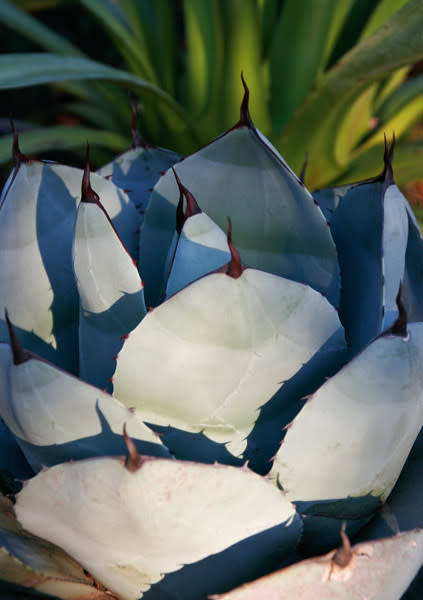
DON'T BE A "ZERO- SCAPER ." Xeriscaping isn't about re-creating the surface of Mars in your front yard. It's actually a time-honored approach to environmentally appropriate, low-water garden design. Avoid zero-scaping by planting luscious, wildlife-attracting plants, including perennials like California fuchsia (Zauschneria), shrubs like manzanita, grasses like Stipa giganteum, and our summer drought-loving native madrone tree.
LET THE RAIN BLOOM . Don't fight damp ground by trying to plant things you wish would grow there. Instead, go with damp-loving species: red-twigged dogwood (Cornus sericeus) and sweet flag (Acorus gramineus), both of which love life under a downspout or marshy areas. Consult Metro's online rain garden plant lists at oregonmetro.gov for more ideas.
WATCH THE WEEDS . How much we should combat invasive species is a hot issue in our region. But nobody can deny that English ivy, blackberry, and a handful of other exotic weeds encroach on native habitat and overtake more desirable plants. Take the time to learn about which plants are invasive in our area and remove them from your own garden. SOLV offers excellent information and volunteer opportunities.
Expert Tips
The Right Plants
Lance Wright | Horticulturist, City of Portland

I'm a geography junkie. It comes into play when I garden at home and at work. I don't adhere strictly to an Oregon palette of plants—maybe more West Coast—but above all, I try to plant Mediterranean-climate plants that don't require extra summer water.
Of course, everyone gets seduced by plants—I still do— but I really try to learn about each of them. Where did it come from? What's the climate like there? Can I provide it with similar conditions? Look at soil conditions, drainage, sun and shade, as well as local climate. You can't just plant the same set of cookie-cutter plants that have been successful somewhere else—go with what's appropriate to the site.
STARTER KIT
Plants: For dry areas, select plants from regions that have wet winters and dry summers: types of Ceanothus, manzanitas ( Arctostaphylos ), yuccas, penstemon, salvia, and California fuchsia (Zauschneria).
Make a Habitat
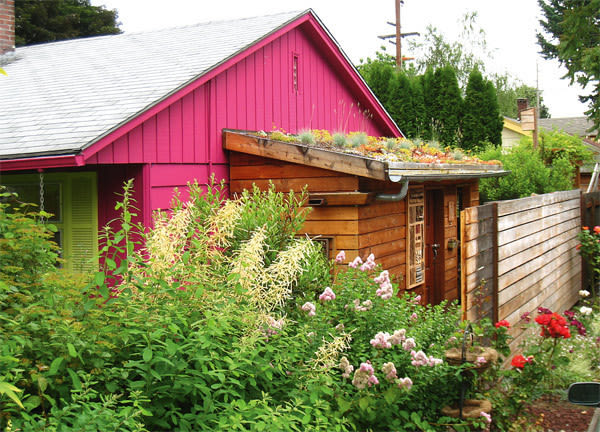
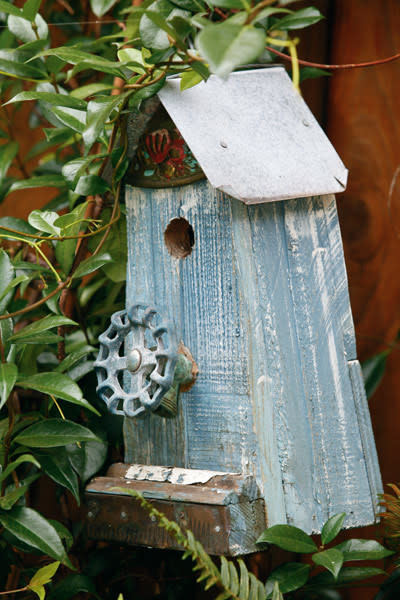
GO MULTISPECIES . Why should only humans admire your garden? The best home for birds and pollinators is a diverse one. Plant in layers, with open patches of soil for ground-foraging birds, knee-high perennial flowers for seed head and perches (the flexible, wandlike stems of lilies seem to be favorites), and shoulder-level thickets of shrubs with an open habitat (not tightly clipped) for cover and nesting. Grow trees for absolutely everything. You can even get official with a Backyard Habitat Certification from the Audubon Society of Portland.
FEED YOUR FRIENDS .Grow plants that provide seeds (asters) and nectar (fuchsia) for a more eclectic set of neighbors. Plant old-fashioned echinacea and sunflower, and birds will pick seed right off the plant. Native fruiting shrubs like snowberry and huckleberry provide birds with a buffet. Plant nectar-rich red flowering currant for spring, Phygelius for summer, fuchsia for fall, and winter-flowering mahonia if you want the hummingbirds around all year long.
LEAVE A MESS . Repress your inner neatnik and don't clean up your garden until late January. By holding off on cutting back dead lily stalks and scruffy fuchsia stems, you're providing shelter and perches for winter birds, as well as habitat for insects (high-protein bird chow). Consider making a loose brush pile in an out-of-the-way spot to offer shelter and nesting for smaller birds.
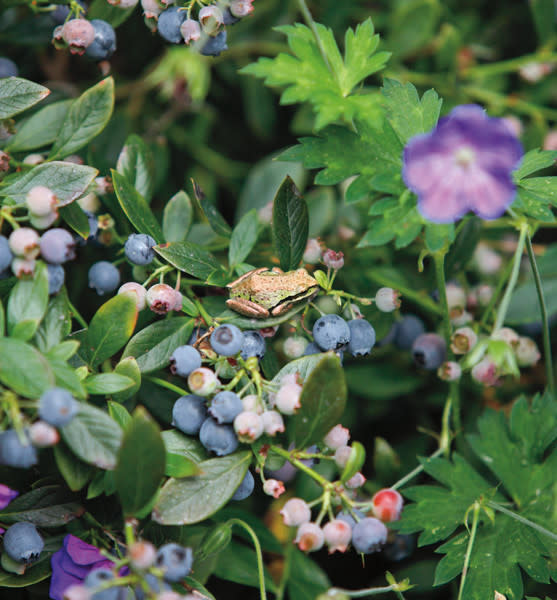
SUPERCHARGE THE BUFFET . Recent studies at Oregon State University suggest "superfood" plants best draw insects and pollinators: asters, alyssum, basil, cilantro, cosmos, fuchsia, nasturtiums, sedum, and sunflowers, as well as such trees as dogwood, fruit trees, and willow.
ADD A BIRDHOUSE . Head over to the Portland Audubon Society or to the Backyard Bird Shop to find the specific kind of bird feeders and nesting boxes that will attract the species you want hanging out in your yard.
CREATE A BUZZ . Even if you don't have the time and money to commit to beekeeping, you still can provide habitat for nonaggressive, ground-dwelling solitary types like the industrious orchard mason bee. These and other solitary bees pollinate fruit trees, small fruit, and vegetables, thereby improving yields. You can buy or make nesting cubes, or simply leave dry, sunny banks of soil free of vegetation. For more information, consult the Xerces Society website (xerces.org).
Expert Tips
Naturescaping
Marina Wynton | Garden designer, Olivine Landscape Design

After I was in architecture school, I saw that something had to be done about the environmental problems we were facing. At the time, I was sitting in front of a computer in an office all day. I wanted to do more. So I started to work with people to solve environmental problems in their own spaces.
"Naturescaping" is a way of designing a garden to support wildlife. We select plants to provide habitat for insects, which will then draw native birds, frogs, snakes, and other creatures. Why snakes and frogs? They keep mosquitoes down. And frogs sound great!
Each project gives me a chance to educate people on what they can do environmentally in their own yards. Naturescaping is not necessarily low-maintenance, although it can be. But it is a step toward repairing the environmental problems we face as a society.
STARTER KIT Learn: View a PDF of Portland's Native Plants at portlandonline.com/bps. Choose the right natives for your neighborhood and attract the native creatures specific to the habitat you're rebuilding.
Plant:Opt for natives in groups of 3 to 5 for each variety. For the choices best suited for your neighborhood, visit portland?online.com and consult the Portland Plant List.
Be an Art Patron (or an Artist)
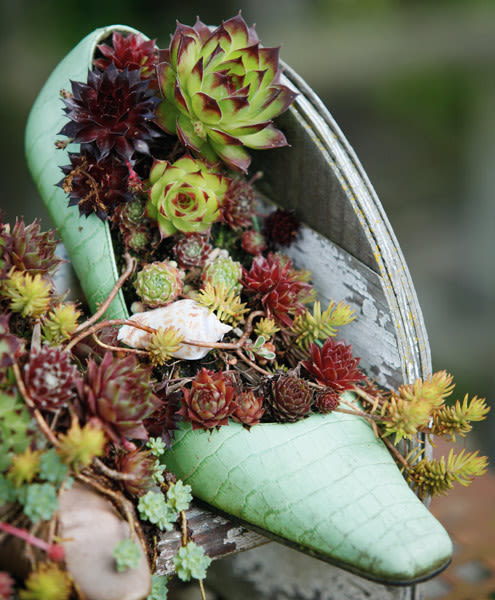
UNLEASH YOUR CREATIVITY . Portland's recycling ethos has no greater expression than in its citizens' gardens. The best art can come from your own basement. Dig up that old bike or lamp shade to reincarnate the perfect trellis, planter, or decoration. Elevate that exquisite stone figurine from Thailand on a pedestal to make an outdoor altar. That lovely gnarled branch you gleaned on a beach trip? Set it in a garden bed and add a little vine like Clematis integrifolia or sweet peas. Beautiful, funny, funky, or elegant—custom-made art makes a great conversation starter.
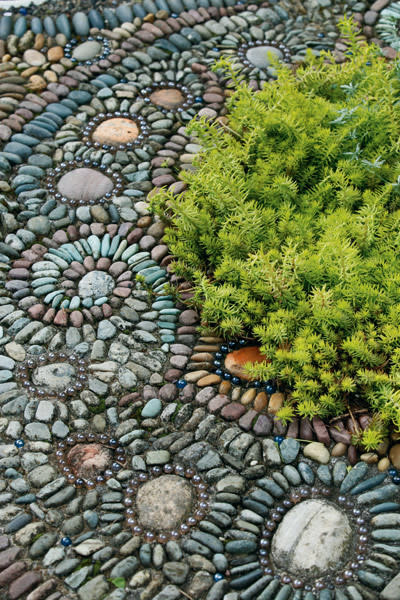
KNOW THYSELF . Portlanders are nothing if not inventive, but it's best to leave anything technical and permanent to the experts. If you're into sleek, contemporary concrete or the funky, bohemian look of handmade mosaic paths, but designing or building them isn't in your skill set, find the designer or craftsperson of your dreams, ask people whose gardens you admire, or check out the Association of Northwest Landscape Designers.
BE A PATRON . Support your local artists. Cracked Pots' annual July sale at McMenamins Edgefield is legendary for great garden finds. Pieces run the gamut from lowbrow repurposed punched tin-can lanterns to upscale recycled metal installation pieces. Great local garden shops like Digs Inside & Out on NE Alberta Street and Dig, in the Pearl, offer great locally made art.
REMEMBER SCALE . Art needs to rise to the occasion of the outdoors. Think big or in multiples, especially with small pieces, which can disappear into the foliage or landscape.
GET PICTURESQUE . Think about your garden as a painting, whether seen from your front stoop or from a chair through a window. Place art within your fondest views. Keep plantings simple around fussy art. Modern objects look great with bold, monochromatic plantings. A colorfully painted birdhouse will be enhanced by voluptuous, old-fashioned cottage garden flowers like foxgloves, daisies, love-in-a-mist, and black-eyed Susan.
Expert Tips
DIY Garden Art
Nancy Goldman | Retired PSU administrator; recycled-art creator

I'd seen people use boots as planters, but that wasn't fancy enough for me. So I tried some little shoes. I drilled holes in the bottom and filled them with soil, planted them, and displayed them on a shoe rack.
I got a lot of the shoes in secondhand stores in North Dakota, where I'm from. I got one pair from an estate sale where the husband told me his deceased wife had worn them dancing. I liked that. They don't last forever—but that's fine. Nothing's permanent.
I'm a Dumpster diver, and I've always found things for inside my house and my garden. It speaks to my aesthetic—making something traditional nontraditional. A while back, I started using alphabet magnets. I've got little sayings throughout the garden. One of them is "Hortus meus culum calcitrat"—my garden kicks ass.
STARTER KIT
Plants: Sedums, sempervivums
Planters:Trawl thrift stores for funky shoes, dishes, and bits of architectural salvage.
Stock Your Kitchen
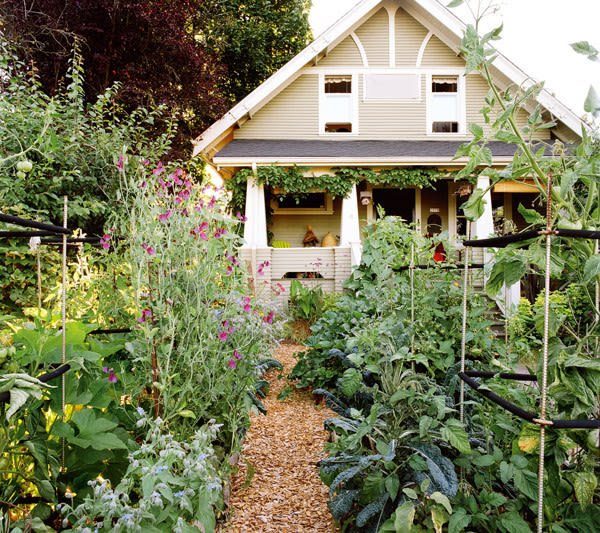
SEED LOCAL . Portlanders love to buy local. Planting locally grown and adapted seeds has its advantages, too. Regional seed companies select varieties that do well in our climate, and growing your own—especially if you're planting a large garden—is certainly cheaper than buying starts. For the local touch, buy your seeds from companies like Wild Garden Seed, Adaptive Seeds, Horizon Herbs, Uprising Seeds, and Siskiyou Seeds.
TAKE IT TO THE STREETS . Older neighborhoods with tightly packed houses and tall trees often have scant sun available. If the best light you have falls on the parking strip or front lawn, turn that dry turf into a flourishing vegetable garden. Don't be daunted by dogs, marauding kids, and people stepping out of their cars onto the lettuce—you're now part of an international movement called Food Not Lawns.
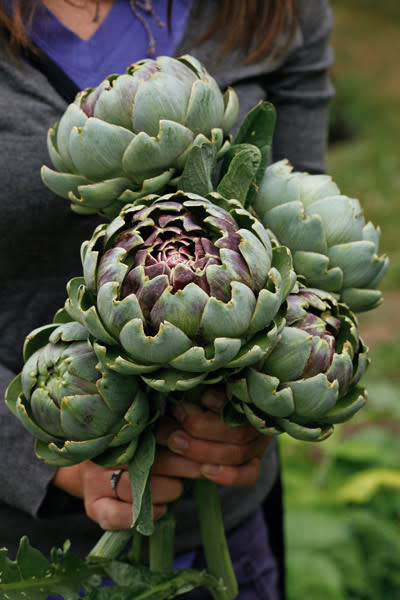
NURTURE FAMILY HEIRLOOMS . Developed for their flavor and texture (rather than a tough skin for shipping), heirlooms and open-pollinated vegetable varieties are excellent for home gardeners, both for culinary quality and because the seeds can be saved and planted next year. In fact, if home gardeners and small farmers didn't grow them, heirlooms would disappear.
GROW FRUITS TO NUTS . Apples, plums, pears, Asian pears, cherries, figs, grapes, kiwis, raspberries, blueberries, walnuts, filberts—we are blessed to be able to grow these and many more edibles in Portland. On smaller lots, dwarf and espalier-form trees are your best option. If you have a large tree and can't handle the abundance, don't let it go to waste: donate your yield to the Portland Fruit Tree Project or Urban Gleaners. Volunteers are happy to harvest.
GROW ORGANIC . All plants really need is the proper light, moisture, nutrients, and temperature conditions, and they can outgrow most basic insect and disease problems, insecticide free. Diversity in your garden plot also helps, as does planting extra to allow for a certain percentage of loss. Consult Metro's natural gardening website at oregonmetro.gov.
TRY POTS . Growing herbs and vegetables in containers is smart, even if you do have plenty of yard space. They can be beautiful. They keep food close at hand and the slugs out. And if you live in a cool pocket or higher-elevation area, heat-loving summer vegetables like tomatoes and melons can grow faster in sun-warmed containers.
POOP IS GOOD . If you have room for chickens, goats, ducks, or bunnies, all the better for your garden. But if keeping pets isn't an option, try worms—they're one of the best ways to boost the health and productivity of your vegetable garden soil. Follow the simple directions that come with a worm bin, keep it drained and emptied of worm castings, and you'll be able to store it in or near your kitchen for easy compost disposal.
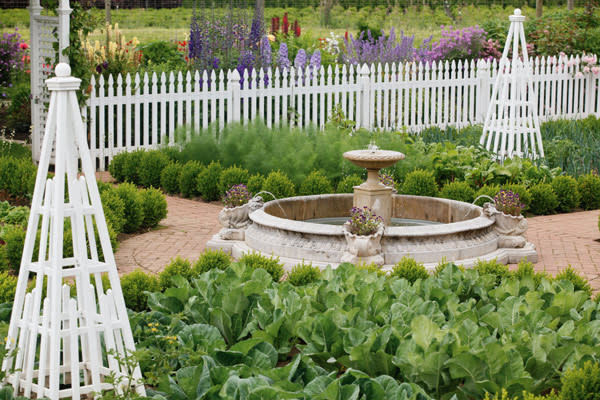
KEEP YOUR SCRAPS . It's fabulous that we can dump our table leftovers in the green yard debris bins now, but kitchen scraps can also provide you with your own "gardeners' gold." Pick up an inexpensive compost bin from Metro to get started. Layer food scraps with dry lawn clippings, leaves, straw, or fine wood chips. If you eat in a lot, even better: get two containers so one can "cook" while you fill the other.
COVER UP. Crimson clover, winter peas, and fava beans are great to plant in fallow soil. Cover crops like these can break up compacted soil, stop erosion, and improve nutrient content and healthy fungi. Just dig up the soil enough to plant, pick a suitable cover crop for the season, and chop them down (usually just before flowering) so they decompose and improve the soil. Don't assume the seeds are the right ones for the season just because they're available at the store—ask.
Expert Tips
Grow Your Own
Pat Collins | Retired flight attendant; avid gardener and chicken-keeper

The first vegetables I grew, years ago, were tomatoes and basil. They weren't necessarily to eat. I wanted something beautiful to look at. But those first few tomato and basil plants were so productive, I got hooked. They're quick and provide almost instant gratification—and they're much less intimidating for beginning gardeners. Nowadays, I don't care how my vegetable garden looks so much. I do it to feed my soul.
You can grow lettuce blindfolded. The list of easy vegetables to grow is so long: potatoes require almost no effort, figs are some of the easiest fruit trees, and strawberries are so wonderful to have. Even though you can get them fresh at farmers markets nearly all summer, it's so great to pick them throughout the summer and pop them, fresh from the garden, in your cereal bowl.
STARTER KIT
Soil: There's no replacing homemade compost for your vegetable garden. (See Metro's guidelines at oregonmetro.gov.)
Plants:Keep it simple at first, planting kale, lettuce, and strawberries. Then branch out.
Make a Parking-Strip Sanctuary
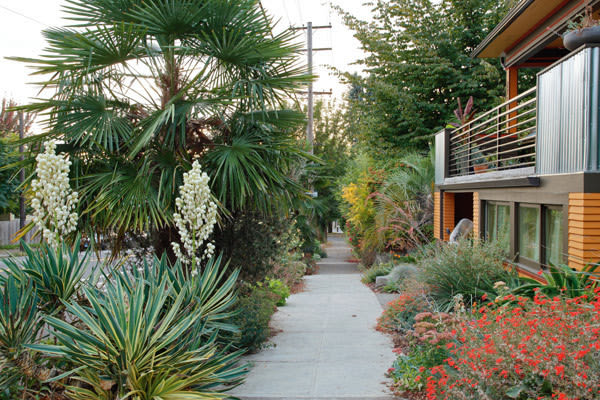

BLAST YOUR "HELLSTRIP." That's what garden geeks call the too-often neglected zone between street and sidewalk. But in Portland, they've become the equivalent of the natty scarf that ties a great outfit together. Before you start, consider a few ground rules: the city of Portland owns your parking strip, so don't start digging without knowing the regulations for gas lines, what kind of trees you can plant and where, or how to keep the water meter box accessible. Check out the regs at portlandonline.com.
CONNECT PLANTS AND PLACE . If your planting strip is shady, try winter-blooming dwarf Himalayan box (Sarcococca hookeriana v. humilis), which blossoms with fragrant flowers in January and February. Greedy tree roots to contend with? Native Vancouveria and sword ferns need little water, and can deal with shade and compete with tree roots. Is it sunny? Try sun-loving, drought-tolerant hotties like manzanitas, rosemary, and Salvia x greggii . Partial sun? Go for star jasmine ( Trachelospermum asiaticum) or sedums.
KNOW YOUR SOIL . To turn your hellstrip into a curbside heaven, good soil will be your guiding angel. Start by loosening it between six inches and two feet deep (less for shallow-rooted ground covers like creeping sedums or thyme, more for shrubs and trees). Incorporate compost tailored to your intended plantings. And don't let your soil overflow onto the street—very salmon-unfriendly.

PLAN FOR THE WALKERS . Carbon offsets from colonizing your parking strip aside, folks parking on the street need to get in and out of their cars, so leave some zones of brick or concrete "hardscaping."
PLANT AN ALTERNA - LAWN . If you're ready for a little more work, low-growing "steppables" are great: creeping sedum or thyme (for sun), Acaena or Cotula (for half sun), or blue star creeper (for shade). Other options include small, grasslike plants such as dwarf Ophiopogon.
PLAY CHESS WITH TREES . Tired of looking at your neighbor's unkempt lawn? Want your car shaded from the afternoon sun? Block either with a strategically placed tree. First, check to see if Friends of Trees will be planting in your neighborhood and join it if you can. If not, search the city's list for a drought-tolerant tree species with the right height, width, and maybe even flowers at portlandonline.com.

Expert Tips
Clever Curbs
Lucy Hardiman | Writer; garden designer, Perennial Partners
I come from a family of pioneers that traveled in the first wagon train from Independence, Missouri, to Independence, Oregon. They carried seeds, and stuck treasured cuttings in potatoes to preserve them. What we now call "sustainable" was how we were taught to live on the planet.
When I moved to Portland, the big parking strips all over town didn't make any sense to me. To maintain a lawn in the two feet of clay soil between street and sidewalk, people were watering and using herbicides. So at our house, I had a crew take out the top 12 inches of soil. We added soil amendment and pumice and mulched with a quarter-10 gravel so we could plant a drought-tolerant garden. You need drainage. It's not the winter cold that kills most plants; it's the wet!
STARTER KIT
Plant:Consider Mediterranean plants like cistus, hellebores, euphorbias, Pacific Coast iris; minor bulbs; and herbs like lavender and sage.
Party with the Animals
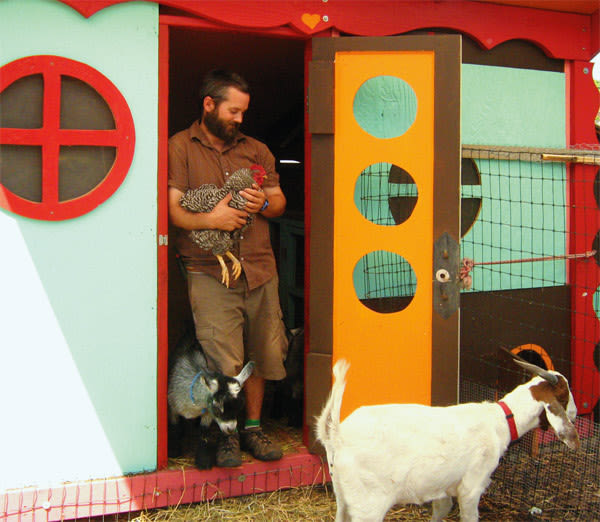
BE AN URBAN HOMESTEADER . A small, fervent contingent of urban Portlanders have kept chickens—and even ducks and quail—for nearly 15 years. Now, it's hard to find a block in the inner city without coops. The word's out: there's just no substitute for fresh, organic eggs.
TAKE A TOUR . Every summer, Growing Gardens hosts the annual Tour de Coops. There is no better way to connect with fellow chicken keepers and see the wide range of available coop styles and chicken breeds firsthand. It's also a great way to see how different people integrate chickens into their garden.
BUILD CHIC ARCHITECTURE . Along with the vogue for backyard animals comes the craze for cool custom chicken coops and goat sheds, and pens in styles ranging from funky salvage to whatever matches perfectly with the architectural scheme of your house. Just make sure the coops and runs you build are designed to keep your creatures safe from marauding raptors, coyotes, and raccoons.
. . . OR A TRAVEL TRAILER . Half the joy in keeping a flock lies in knowing they are improving the health and tilth of your garden. But their little scratching feet can wreak havoc on newly planted seedlings. The solution? A portable chicken tractor, to help you control where the chickens forage.
MOW BILLY . Miniature goats have recently made inroads into Portlanders' hearts, as well as into empty public lots, where they can chew through a forest of weeds in days. They also make fine pets, but to clear those blackberries or trim the lawn, the cautious can rent some through goatrentalnw.com.
Expert Tips
The Homesteader
Naomi Montacre | Owner, Naomi's Organic Farm Supply

The chicken thing all started when I was craving some eggs while we were farming west of Portland and surrounded by neighbors' early-morning rooster calls. Our first five hens are still spunky members of our bigger flock today, six years later. I love watching little tufts of fluff grow into lively, comical characters with unique personalities. Then there's the thrill of that first orange-yolked egg from the nest box you built, drinking fresh milk from your own little goats in the backyard, gathering mohair fiber, and having sweet pets to walk around the neighborhood.
Goats, hens, and ducks are really easy to care for, more like cats than dogs once you get their housing set up—and their manure provides great fertility for your garden.
STARTER KIT
Housing: Buy a coop kit at thegardencoop.com or backyardchickens.com.
Feed: For chickens and goats, grow extra greens (kale, chard, collards, bok choy) and fruits (berries, apples, melons). Goats help keep blackberry bushes at bay, and they all love the berries.
Best Gardening Books For Portland Oregon?
Source: https://www.pdxmonthly.com/home-and-real-estate/2012/03/portland-gardening-guide-april-2012
Posted by: davisdorbacted.blogspot.com

0 Response to "Best Gardening Books For Portland Oregon?"
Post a Comment